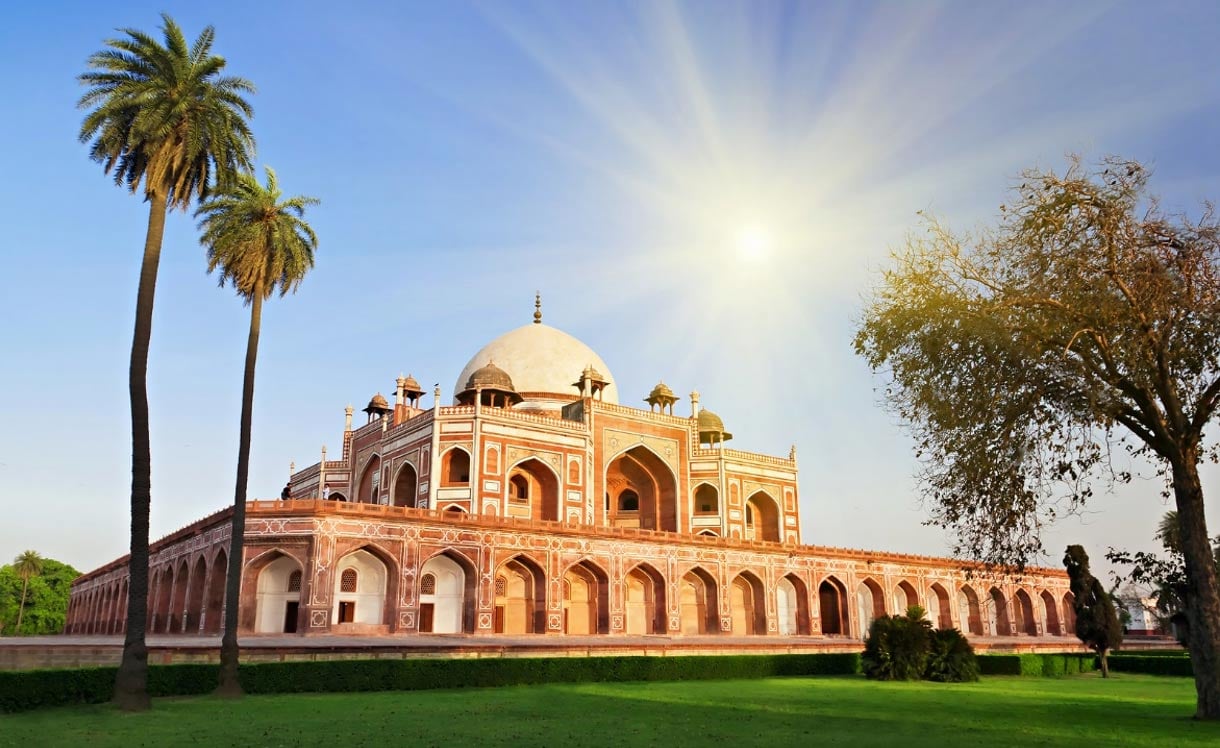The Tomb of Humayun: The Garden Tomb that Inspired the Taj Mahal
The first garden-tomb that was constructed in India was the spectacular Tomb of Humayun devoted to the second Mughal Emperor. So magnificent was the monument, that it came to inspire major architectural innovations throughout the Mughal Empire, including the world-renowned Taj Mahal in Agra, built about a century after Humayun’s Tomb. The construction of this monument symbolizes the peak of Mughal garden-tomb construction.

A monument built in 1572 by Bega Begam in memory of her husband, Humayun. Photo by: Shailabh Suman, 2014. (Wikimedia Commons).
The emperor Humayun lived during the 16 th century. Upon his death in 1556, Humayun was first buried in Purana Quila, a fort in Delhi. When the fort was captured by the Hindu emperor Hemu, Humayun’s body was exhumed by the fleeing Mughals, and transported to Kalanaur in Punjab. In 1569/70, 14 years after Humayun’s death, his first wife, Bega Begum, commissioned a tomb in Delhi for her late husband. The man responsible for designing the tomb was Mirak Mirza Ghiyas, a Persian architect chosen by Bega Begum. It is perhaps thanks to Ghiyas that the tomb was heavily influenced by Persian architecture.

Painting of Humayun of India. 18 th Century. (Wikimedia Commons).

Portrait of Bega Begum (Hamida Banu Begum), whom had the tomb built for her late husband, Humayun. Circa 19 th Century. (en.wikipedia.org)
The garden, which the tomb is set in, symbolizes the Garden of Paradise, and has its origins in Persian char bagh (meaning ‘four gardens’). During the reign of Humayun, this garden layout, also known as the Mughal garden was such a novelty in India, that its design became replicated throughout the Mughal Empire.
The Persian-inspired gardens surrounding Humayun’s final resting place are divided into four parts by causeways. At the centre of each causeway is a shallow water channel, which is connected to pools. The entrances to the enclosure are situated on its south and the west sides, and exist in the form of double-storeyed gateways. Additionally, there is a baradari (pavilion) and a hamman (bath chamber) that occupy the centre of the eastern and northern walls respectively. In the middle of the garden is a 7 m high square terraced platform raised over a series of cells. These cells are accessible through small arches along the sides. It is on this platform that the actual tomb of Humayun is located.
- Controversy in India as Minister says Taj Mahal is part of Ancient Hindu Temple
- Ten Magnificent Ancient Structures of Asia
- Garden and pavilions of the Taj Mahal found to align with rays of the sun

The actual tomb site where Humayun lies buried. Photos by: Jyotsnav, 2013. (Wikimedia Commons)
The tomb itself is a double-storey structure built of red sandstone. Although the monument’s plan is a square, its chamfered sides give it the appearance of an irregular octagon with four long and four short sides. The building is topped by a Persian double dome (the first Indian monument to use such an architectural technique), which is 42.5 m in height. This dome is flanked by chhatris (decorative pillared kiosks), which are a distinct Indian architectural feature. Yet, these architectural elements from two distinct cultures complement each other harmoniously, and is an example of the synthesis between Persian and Indian architectural styles.
The interior of the structure is a large octagon. At the centre of this octagon is the grave of Humayun, which is accessible via a passage on the south. Above the octagon are vaulted roof compartments interconnected by galleries and corridors. In addition to Humayun, the graves of other members of the royal family can be found in the structure. These are located in the corner-chambers at the diagonal sides of the central chamber. It has been claimed that there are about 150 graves in total, hence its description as a ‘necropolis of the Mughal dynasty’.

Humayun’s family members are also buried here. Photo by Dennis Jarvis, 2007. (Wikimedia Commons)
By the latter half of the 20 th century, the Tomb of Humayun was in a state of disrepair, as the masonry and stonework were broken and cracked, and the gardens were run down. It was in 1997 that restoration of the garden surrounding the tomb was undertaken by the Aga Khan Trust for Culture, and was completed in 2004. In 2007, however, a project for a six-lane link from the National Highway-24 was proposed. This threatened the Tomb of Humayun, as it increased pollution, and brought traffic much closer to the monument. As a result of opposition, the project was abandoned. In the same year, further conservation work was carried out on the Tomb of Humayun, bringing the grand monument back to its former glory.
In June, 2018, there was great excitement among archaeologists and conservationists, who discovered hidden Mughal treasure near Humayun's tomb – paintaings in blue, yellow, red, white, and gold, which had been hidden beneath layers on the domed ceiling of Sabz Burj, a 16 th century Mughal monument near Humayun's tomb. It was the first time early 16 th century wall paintings were found on a monument in Delhi.
Read more at:
http://timesofindia.indiatimes.com/articleshow/64656311.cms?utm_source=c...
Featured image: Humayan’s Tomb. Source: BigStockPhoto
By Ḏḥwty
References
Archaeological Surveyof India, 2011. World Heritage Sites - Humayun's Tomb. [Online]
Available at: http://asi.nic.in/asi_monu_whs_humayuntomb.asphttp://asi.nic.in/asi_monu_whs_humayuntomb.asp
Kamiya, T., 2015. Humayun's Tomb in Delhi. [Online]
Available at: http://www.kamit.jp/02_unesco/12_humayun/hum_eng.htm
The Hindu, 2007. Humayun's Tomb faces twin threats. [Online]
Available at: http://www.thehindu.com/todays-paper/tp-national/tp-newdelhi/article1855667.ece
Theismaili.org, 2013. Humayun’s Tomb restoration a model of public-private partnership. [Online]
Available at: http://www.theismaili.org/news-events/humayun%E2%80%99s-tomb-restoration-model-public-private-partnership
UNESCO, 2015. Humayun's Tomb, Delhi. [Online]
Available at: http://whc.unesco.org/en/list/232
Waugh, D. C., 2001. Humayun's Tomb. [Online]
Available at: https://depts.washington.edu/silkroad/cities/india/delhi/humayun/humayun.html



















